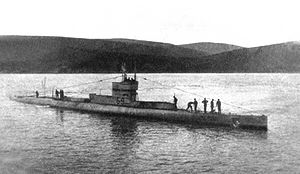British G-class submarine
 G9
| |
| Class overview | |
|---|---|
| Name | G |
| Builders | Chatham Dockyard, Armstrong Whitworth, Vickers, Scott's |
| Operators | |
| Completed | 14 |
| Cancelled | 1 |
| Lost | 4 |
| Scrapped | 10 |
| General characteristics | |
| Type | Submarine |
| Displacement | list error: <br /> list (help) 703 long tons (714 t) surfaced 837 long tons (850 t) submerged |
| Length | 187 ft 1 in (57.0 m) |
| Beam | 22 ft 8 in (6.9 m) |
| Draught | 13 ft 4 in (4.1 m) |
| Installed power | list error: <br /> list (help) 1,600 bhp (1,200 kW) (diesel) 840 hp (630 kW) (electric motor) |
| Propulsion | list error: <br /> list (help) Diesel-electric 2 × diesel engines 2 × electric motors |
| Speed | list error: <br /> list (help) 14.25 knots (26.39 km/h; 16.40 mph) surfaced 9 knots (17 km/h; 10 mph) submerged |
| Range | 2,400 nmi (4,400 km; 2,800 mi) at 12.5 kn (23.2 km/h; 14.4 mph) surfaced |
| Complement | 22 |
| Armament | list error: <br /> list (help) 4 × 18-inch (45 cm) torpedo tubes 1 × 21-inch (53.3 cm) torpedo tube |
The Royal Navy's G-class of diesel/electric submarines were launched between 1914 and 1917, and intended for operations in the North Sea and German Bight in World War I against German U-boats.
Description
The G-class submarines were designed by the Admiralty in response to a rumour that the Germans were building double-hulled submarines for overseas duties. The submarines had a length of 187 feet 1 inch (57.0 m) overall, a beam of 22 feet 8 inches (6.9 m) and a mean draft of 13 feet 4 inches (4.1 m). They displaced 703 long tons (714 t) on the surface and 837 long tons (850 t) submerged. The G-class submarines had a crew of 30 officers and other ranks. They had a partial double hull.[1] The design showed little improvement in practice, the ships being notoriously slow to dive.[2][3] The G-class had their bows raised during the war to increase buoyancy and improve seakeeping.
For surface running, the boats were powered by two 800-brake-horsepower (597 kW) diesel engines, each driving one propeller shaft. When submerged each propeller was driven by a 420-horsepower (313 kW) electric motor. They could reach 14.25 knots (26.39 km/h; 16.40 mph) on the surface and 9 knots (17 km/h; 10 mph) underwater. On the surface, the G class had a range of 2,400 nautical miles (4,400 km; 2,800 mi) at 16 knots (30 km/h; 18 mph).[1]
The boats were intended to be armed with one 21-inch (53.3 cm) torpedo tube in the bow and two 18-inch (45 cm) torpedo tubes on the beam. This was revised, however, while they were under construction, the 21-inch tube was moved to the stern and two additional 18-inch tubes were added in the bow. They carried two 21-inch and eight 18-inch torpedoes. The G-class submarines were also armed with a single 3-inch (7.6 cm) deck gun.[1]
Boats
A total of 14 boats were built at four yards: G1 to G5 by Chatham Dockyard, G6 & G7 by Armstrong Whitworth, G8 to G13 by Vickers, and G14 by Scott's on the Clyde. G15 was ordered from Samuel White's yard at Cowes, Isle of Wight, but cancelled.[4]
- G1 - Launched 14 August 1915. Sold for scrap 1920.
- G2 - Launched 23 December 1915. Sank U-78 in the Skagerrak, 28 October 1918. Sold for scrap 1920.
- G3 - Launched 22 January 1916. Sold for scrap 1920.
- G4 - Launched 23 October 1915. Sold 1928.
- G5 - Launched 23 November 1915. Sold 1922.
- G6 - Launched 7 December 1915. Sold 1921.
- G7 - Launched 14 March 1916. Last British submarine lost in World War I, on or about 23 October 1918, cause unknown.
- G8 - Launched 1 May 1916. Lost in the North Sea for reasons unknown on or about 14 January 1918.
- G9 - Launched 15 June 1916. Sunk in error by HMS Pasley on 16 September 1917. One survivor.
- G10 - Launched 11 January 1916. Sold 1923.
- G11 - Launched 22 February 1916. Wrecked on rocks off Howick, Northumberland, in thick fog, 22 November 1918. Two crew drowned while abandoning ship.
- G12 - Launched 24 March 1916. Sold 1920.
- G13 - Launched 18 July 1916. Sank UC-43 off Muckle Flugga, 10 March 1917. Sold 1923.
- G14 - Launched 17 May 1917. Sold 1923.
- G15 - Ordered 30 September 1914, cancelled 20 April 1915
Notes
- ^ a b c Gardiner & Gray, p. 90
- ^ Arthur, M. (1997). Lost voices of the Royal Navy, pp. 84. Hodder & Stoughton Ltd, London. ISBN 0-340-83814-0
- ^ Yorkshire-divers.com
- ^ www.rnsubmus.co.uk
References
- Colledge, J. J.; Warlow, Ben (2006) [1969]. Ships of the Royal Navy: The Complete Record of all Fighting Ships of the Royal Navy (Rev. ed.). London: Chatham Publishing. ISBN 978-1-86176-281-8.
- Gardiner, Robert; Gray, Randal, eds. (1984). Conway's All the World's Fighting Ships: 1906–1921. Annapolis, Maryland: Naval Institute Press. ISBN 0-85177-245-5.
{{cite book}}: Unknown parameter|lastauthoramp=ignored (|name-list-style=suggested) (help) - McCartney, Innes (2008). British Submarines of World War I. New Vanguard. Vol. 145. Oxford, UK: Osprey. ISBN 978-1-84603-334-6.
External links
![]() Media related to British G class submarines at Wikimedia Commons
Media related to British G class submarines at Wikimedia Commons
